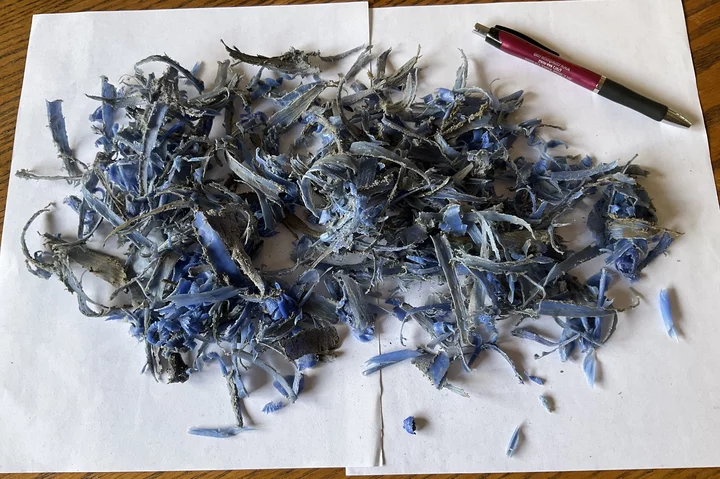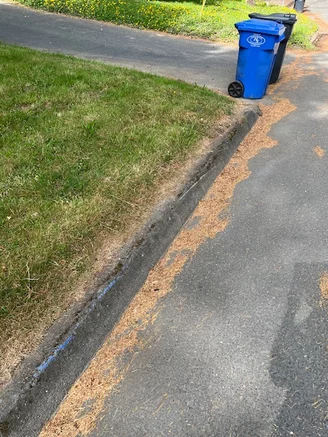Shards of recycling containers collected by the author in McKinleyville. Photo: Dan Levinson.
You’ve probably seen the smudges and lines of what looks like light blue paint on the streets, always in front of garbage containers or where they have recently been. A closer look reveals that it is blue plastic rubbed off the bottom of recycling and garbage receptacles when they are dragged by service trucks. You might have also noticed curlicues of plastic being stripped from the bottoms and sides of the bins, either from abrasion on the streets or from the large metal forks that move the receptacles. Though nearly all the scuff marks are on street surfaces, the one in the picture represents a container being dragged along an elevated curb. I include it here because it’s the clearest example from several photos taken over a few years. The other picture shows curlicues and scraps I’ve collected on my neighborhood walks in McKinleyville.
It might be unrealistic to expect Recology — our laudable cleanup and recycling enterprise — or any other company on the planet that works on this large scale, to replace their containers, at least in the short term. However, I’ve written this piece in an attempt to get the ball rolling, hoping that others will join my voice for change. At this point in our collective ecological consciousness, it is glaringly known how toxic and pervasive plastic is. I don’t need to detail how its overuse, alongside other devastating practices such as blithely hopping on airplanes for vacations, is destroying species and habitats. (This world traveler hasn’t been on a plane since 2019 — but that’s another article.)
Four years ago I brought a small bag of the blue shavings to the Recology office, simply to share evidence that a company with such a name is actively creating plastic waste headed directly into the gutters and then the ocean. The employee I spoke with was just about polite, but I got the sense that she thought me a weirdo and I was pretty sure that little bag was headed straight for the trash and not to any future meeting regarding clean practices. From there I contacted a couple of people at the Northcoast Environmental Center, emailing images of smudges and streaks on the streets, as well an image of the shavings. Our communication went well enough in the moment but did not lead to any change.
Surprisingly, I have not found references to any cities having addressed plastic waste generated from recycling and trash bins. I have come across the suggestion to apply protective coatings (but of what?) to a bin’s underside or placing a buffer material between the bin and asphalt. Might the arms of the metal forks get a rubber wrap to avoid cutting into the plastic? Could Humboldt County set a precedent in trying to solve this? Arcata’s city council, after all, was the first in the nation to have a Green Party majority. My friends and I, naively, used to refer to Humboldt as Ecotopia — but the county still sets stellar examples of different environmental practices. Just think of the transformation that became the Arcata Marsh and Wildlife Sanctuary.
What to be done, then? Recology might respond if citizens visit their office with little bags of blue plastic shavings, followed up by letters, phone calls, and photos. We could make a sculpture of plastic bits and set it in the Arcata Plaza to replace President McKinley, akin to the Artula Institute’s Washed Ashore project: you may have seen the elaborate sculptures fashioned from ocean waste on display in Bandon, Oregon and elsewhere. Perhaps most effectively, Recology could put an employee to the task of sorting this out. In the meantime, I’ll keep picking up trash on my daily walks and talking to kids about good practices as I teach my poetry residencies. The steps to be taken range from small to global. For instance, it’s hard to imagine that any readers are still buying sponges made with petroleum-based plastic — which means choosing to put plastic directly into their drains — when alternatives are sitting right next to them on our store shelves. The kids know what’s happening and they wonder when the adults will stop sleepwalking.
###
Dan Zev Levinson is a teacher and a poet. His website is zevlev.com.


CLICK TO MANAGE